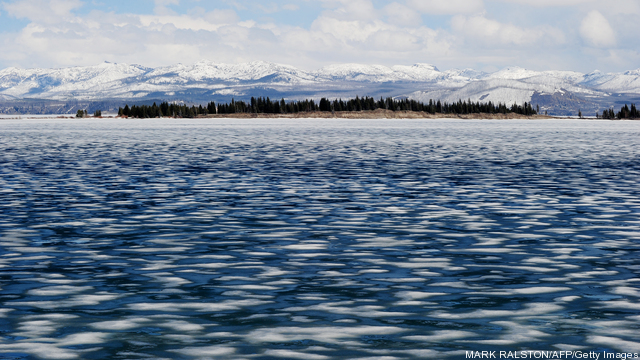Opening up the Arctic National Wildlife Refuge to exploration and development has long been a contentious issue, and Alaska Governor Sean Parnell made a push earlier this week to reopen the debate. Parnell presented Interior Secretary Sally Jewell with a detailed proposal for a seven-year program to conduct 3-D seismic exploration of ANWR area 1002 for the first time.
How much oil are we talking about?
The United States Geological Survey’s March 2013 estimate for undiscovered, technically recoverable oil resources in ANWR, at almost 10.4 billion barrels, accounts for more than a quarter of the 40 bn bbls onshore total. The Bureau of Ocean Energy Management’s most recent Outer Continental Shelf resource assessment, last updated in 2012, estimated mean undiscovered, technically recoverable oil at 88.6 bn bbls. ANWR would represent 8% of the combined onshore and offshore total.
Resources are a tricky business. Unlike proved reserves, it does not need to be demonstrated with reasonable certainty that resources can be economically produced under existing conditions. It is far from guaranteed that they will ever be developed.
Establishing ANWR’s proved reserves has not been possible. Proving reserves requires levels of activity – such as production or formation tests, or core or log analyses – that have not yet taken place in ANWR. The refuge remains closed to oil and gas exploration and development.
“It’s a moratorium area,” Energy Information Administration (EIA) reserves analyst Steve Grape told Breaking Energy. “It has zero proved reserves.”
The reference case in the EIA’s 2013 Annual Energy Outlook (AEO) projects that US oil output will grow by an average of 234,000 bbls/d through 2019, to 7.5 mn bbls/d, before declining gradually from around 2020 to 2040. ANWR oil does not factor into this forecast, or any other in the 2013 AEO.
“ANWR is assumed to remain closed to oil and gas drilling in all of the Annual Energy Outlook 2013 scenarios, including the Reference and High Resource cases,” EIA analyst Philip Budzik told Breaking Energy.
And estimates for ANWR resources are based on limited information.
“During the preparation for establishing the Arctic Refuge [ANWR], Congress authorized two seasons of ‘exploration’. That included a collection of seismic data, and of course this was in 1984-85, so it was 2-D data, since 3-D seismic was just a glimmer in the eyes of explorationists at the time,” David Houseknecht, project chief for the USGS’ most recent ANWR area 1002 assessment, told Breaking Energy.
“That is the only data set that is available in terms of subsurface geology,” Houseknecht said.
The USGS used those seismic surveys, along with additional data components relevant to the area’s geology, to generate an updated assessment in the late 1990’s. This new assessment estimated mean technically recoverable oil in area 1002 – a 1.5 million acre slice of ANWR considered to be most prospective for oil and gas – at around 7.7 billion barrels, excluding state and native lands. The assessment ranged from 4.3 bn bbls at the low end to 11.8 bn bbls at the high end.
For the broader ANWR Coastal Plain, which includes area 1002, as well as State and Native lands, technically recoverable oil was estimated at 5.7 to 16 bn bbls, with a mean of 10.3 bn bbls.
While the USGS carried out this assessment with the same rigor it would apply to any basin, available data is simply lacking. And Alaska Governor Sean Parnell is calling for new seismic studies that could shed more light on what is under the ground in ANWR, specifically in area 1002, in hopes of finding a means to bolster the state’s oil production.
“It is an area that offers great potential for hydrocarbons,” Charles Ebinger, Director of the Brookings Institution’s Energy Security Initiative, told Breaking Energy. “I would at least think it’s prudent to allow some serious exploratory drilling to find out for sure.”
“With new technologies, like 3-D seismic, we can get a much better idea of what’s there,” Ebinger said.
Careful what you wish for
Advancements in seismic and drilling techniques, as well as updated resource assessments, sometimes result in much higher estimates of how much oil is in the ground, and how much may be recovered. An updated survey of the Bakken Total Petroleum System, which included estimates for the previously-unassessed Three Forks Formation, doubled the USGS’ previous estimate for Bakken oil resources.
But more information does not necessarily mean more oil. “Any time new information is added in a frontier area, it has the potential to change our perspective and our estimates,” said Houseknecht. “But of course there’s not guarantee which way estimates will go – up or down.”
Houseknecht noted that a 2002 assessment of the National Petroleum Reserve-Alaska (NPR-A), where both industry and USGS geologists expected to find large quantities of oil, resulted in a substantial downgrade to previous oil resource estimates. “That’s just kind of the way life is in frontier basins, and that’s one of the reasons we try to emphasize that there is a very wide range of uncertainty in those estimates,” Houseknecht said.
“Industry was equally surprised – companies had invested over $2 billion. For the most part, those leases in NPR-A have been dropped,” Houseknecht said.
Act of Congress
Further seismic studies of ANWR area 1002 would require an act of congress to proceed. Leasing in ANWR’s State and Native lands – which hold about 26% of the estimated technically recoverable resources – do not require congressional action, but the USGS does not expect them to be developed unless federal lands are opened up to exploration and development. This raises the question of whether there is political appetite in Washington to wade back into the fray.
See The Case for ANWR Oil Part II: Gauging Political Appetite for ANWR Drilling

